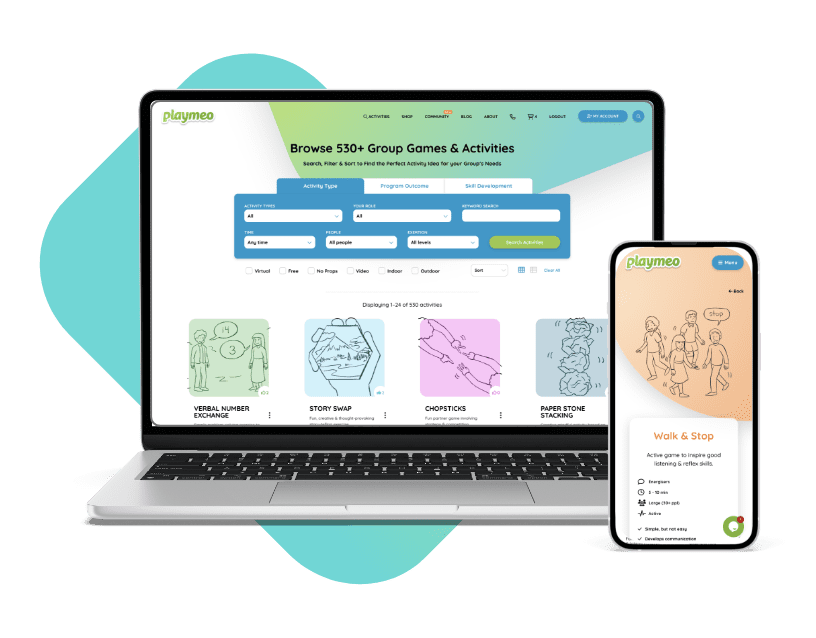Download our free 28-page ebook jam-packed with outrageously fun activity ideas.
None of us enjoy being forced or coerced to do something we don’t want to do.
Even when these ‘things’ are good for you, an approach that gives you the power to choose will always be more successful than feeling under pressure to participate because of some threatening external factor, such as my peers, the boss, a teacher, etc.
You can’t change the way people think or act until you have changed the way they feel – this is a fact. Therefore, recognising that authentic change comes from within, this tool creates an environment within which people can feel comfortable making decisions consistent with, and appropriate to, the overall goals of your program.
In short, honouring choice helps interactions flow.
What Is Challenge by Choice?
A term first coined by Karl Rohnke (and later popularised by Project Adventure), Challenge by Choice is a powerful programming tool that states that people have the choice to determine their own level of involvement in any given activity. Nobody is or should be coerced to do anything they don’t want to do.
Notice then, that Challenge by Choice shifts the responsibility onto you, the program provider, to create n environment that encourages your group’s participation. Or, in other words, to create a space within which people can step outside their Comfort Zones into their Stretch Zones. This is exactly as it should be, and not the other way around.
Yet, if you take a good look around, you’ll discover a disturbingly different picture. I have seen and been a part of too many programs which do nothing to foster a supportive environment, and just expect people to participate. Yet some program leaders wonder why they meet resistance.
It’s More Than Just Saying ‘No’
However, embracing this tool as a core theme of your programming approach is more than simply allowing your participants to say “No” and pull out of an activity.
Honouring Challenge by Choice allows people to pull back from a challenge that may push them into their Panic Zone, and rather than pull out, invites them to find another role (hopefully within their Stretch Zone) that works for them. You could call this a Challenge of Choice, whereby someone chooses their level of challenge.
For example, allowing an individual to choose not to be physically carried across the ‘peanut-butter’ pit as part of the Nitro Crossing team-building exercise because they would rather participate in the gentler problem-solving process. Or, instead of addressing the whole class, each student is invited to share their response to the teacher’s question with a partner or small group.
When you are profoundly related to this powerful concept of choice, it will permeate every aspect of your program design and delivery.
It’s the difference between “You have to…” and “You are invited to…” Or “If you make a mistake, you have to come into the centre of the circle…” and “… it’s your turn to have some fun in the centre…”
Perhaps you already embrace this concept in your program. Fantastic.
But note, it’s one thing to say “…this program operates under the philosophy of Challenge by Choice…” It’s entirely another thing to be responsible for a program that speaks to, honours, and fosters an atmosphere in which people genuinely feel comfortable to willingly step outside of their Comfort zone.
Environment dictates performance.
To this end, one of your primary responsibilities as a program leader is to create an environment in which all of your group members can make appropriate choices, consistent with the goals of your program.
A Word on Participation
Many people – program leaders and participants alike – often confuse Challenge by Choice with ‘participation.’ This is a simple trap.
A case in point…
Many years ago, I trained a team of police instructors to deliver a program that purposefully mixed police recruits with groups of ‘youth at risk.’ To be honest, I’d be hard-pressed to think of two more diametrically opposed groups.
By mid-morning of the first day, the program was humming along nicely, however, two of the young people chose not to join in. As a part of the facilitation team, I respected their decision to sit out, but I did take it somewhat personally because I could not see any reasons why they should choose to not join in. Ignoring even the urgings of their friends, nothing it seemed could motivate these two girls to participate. By day’s end, the two girls did not move from their comfortable sidelined position.
And then, it happened.
To wrap up the day, the top brass of the police squadron asked the group a few questions, a debrief of sorts, including the stock standard “What did you learn about each other today?”
To my shock, one of the two girls put up her hand. I’m thinking, “What smart-arse comment are you going to make. You didn’t participate all day?”
She replied something to the effect, “I didn’t think the coppers would laugh at the same things we did!” And then it hit me. This girl had been participating all day; she just chose (for whatever reason) to do it from the sidelines. It was one of those ‘aha’ moments we all strive for and was only made possible because of the atmosphere that had been developed during the day, particularly enabled by the use of Challenge by Choice.
If this girl had been forced to participate, I am certain that the result would have been very different.
The girls joined the rest of the group on the second day and had a blast.
Essential Tools
Honouring Challenge by Choice is just one of a set of five essential tools I use to intentionally create a positive learning environment and influence the way people feel.
You can learn more about playmeo’s innovative approach to education by clicking the links below.
- FUNN (Functional Understanding Not Necessary)
- Goal-Setting
- Leveraging Full Value
- Learning Through Reflection
This article about honouring Challenge by Choice has been adapted from No Props No Problem: 150+ Outrageously Fun Group Games & Activities Using No Equipment and Serious Fun: Your Step-by-Step Guide to Leading Remarkably Fun Programs That Make a Difference.






